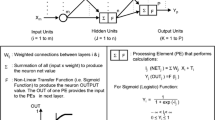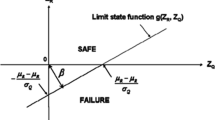Abstract
Friction capacity (fs) of driven pile in clay is key parameter for designing pile foundation. This study employs Gaussian Process Regression (GPR), and Minimax Probability Machine Regression (MPMR) for determination of fs of driven piles in clay. GPR is a Bayesian nonparametric regression model. MPMR is a probabilistic model. Pile length (L), pile diameter (D), effective vertical stress (σ’v), undrained shear strength (Su) have been used as input variables of GPR and MPMR. The output of the models is fs. The developed GPR, MPMR models have been compared with the Artificial Neural Network (ANN). GPR also gives the variance of predicted fs. The results prove that the developed GPR and MPMR are efficient models for prediction of fs of driven piles in clay.





Similar content being viewed by others
References
Burland JB (1973) Shaft friction of piles in clay-a simple fundamental approach. Ground Eng 6(3):30–42
Chandler RJ (1968) The shaft friction of piles in cohesive soil in terms of effective stress. Civil Eng Publ Works Rev 63:48–51
Erzin Y, Cetin T (2013) The prediction of the critical factor of safety of homogeneous finite slopes using neural networks and multiple regressions. Comput Geosci 51:305–313
Goh ATC (1995) Empirical design in geotechnics using neural networks. Geotechnique 45(4):709–714
Kecman V (2001) Leaming and soft computing: support vector machines, neural networks, and fuzzy logic models. The MIT press, Cambridge
Mcclelland B (1972) Design and performance of deep foundations in clay. General Rep Am Soc Civil Eng Spec Conf Perform Earth Earth Support Struct 2:111–114
Meyerhof GG (1976) Bearing capacity and settlement of pile foundations, Eleventh Terzaghi Lecture. J Geotech Eng Div Am Soc Civil Eng 102:195–228
Ni WK, Wang T, Chen WJ, Tan SK (2012) GPR model with signal preprocessing and bias update for dynamic processes modeling. Control Eng Pract 20(12):1281–1292
Pal M, Deswal S (2010) Modelling pile capacity using Gaussian process regression. Comput Geotech 37(7–8):942–947
Park D, Rilett LR (1999) Forecasting freeway link ravel times with a multi-layer feed forward neural network. Comput Aided Civil Infra Struct Eng 14:358–367
Parry RHG, Swain CW (1977a) Effective stress methods of calculating skin friction on driven piles in soft clay. Ground Eng 10(3):24–26
Parry RHG, Swain CW (1977b) A study of skin friction on piles in stiff clay. Ground Eng 10(8):33–37
Randolph MF, Carter JP, Wroth CP (1979) Driven piles in clay-the effects of installation and subsequent consolidation. Geotechnique 29(4):361–393
Strohmann TR, Grudic GZ (2002) A Formulation for minimax probability machine regression. In: Dietterich TG, Becker S, Ghahramani Z (eds) Advances in neural information processing systems (NIPS) 14. MIT Press, Cambridge
Tomlinson MJ (1971) Some effects of pile driving on skin friction Behaviour of piles. Inst Civil Eng 107(I):14
Xia Z, Tang J (2011) Characterization of structural dynamics with uncertainty by using Gaussian processes. In: Proceedings of the ASME design engineering technical conference, pp 1225–1239
Yang LL, Wang Y, Zhang R (2010) Simultaneous feature selection and classification via Minimax Probability Machine. Int J Comput Intell Syst 3(6):754–760
Zhou YR, Xia K (2011) Nonlinear prediction of fast fading channel based on Minimum Probability machine. In Proceedings of the 2011 6th IEEE conference on industrial electronics and applications ICIEA 2011 5975626:451–454
Zhou Y, Huan J, Hao H, Li D (2013) Video text detection via robust minimax probability machine. Int J Digital Content Technol Appl 7(1):679–686
Author information
Authors and Affiliations
Corresponding author
Additional information
Publisher's Note
Springer Nature remains neutral with regard to jurisdictional claims in published maps and institutional affiliations.
Rights and permissions
About this article
Cite this article
Samui, P. Determination of Friction Capacity of Driven Pile in Clay Using Gaussian Process Regression (GPR), and Minimax Probability Machine Regression (MPMR). Geotech Geol Eng 37, 4643–4647 (2019). https://doi.org/10.1007/s10706-019-00928-8
Received:
Accepted:
Published:
Issue Date:
DOI: https://doi.org/10.1007/s10706-019-00928-8




